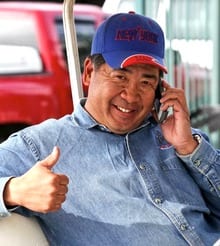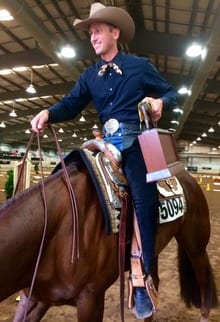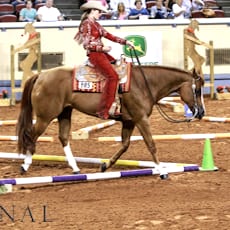“When you’re finished changing, you’re finished,” once said Founding Father Benjamin Franklin. His timeless wisdom still applies to everything, even in the 21st century. But does this simple idea also relate to how we’ve ridden and evolved our horses over the years?
Some would say that the modern trail class, which is a very different event than it was as recently as 10 or 20 years ago, had to change to survive. But are those changes for the betterment of the class?
“My hat is off to everyone, because it is so beautiful now, but it has evolved into what many call pleasure over poles,” explains 72 year-old trainer, Cynthia Cantleberry, whose dominance in the event over the past 50 years has earned her the unofficial title “The Queen of Trail.”
Whether horse show trail is headed in the right direction is for the individual to decide, but wise words from those who have seen it evolve may help to shed some light on the subject.
How It Used to Be
No matter where trainers are in their career, most will say they have seen quite a shift in trail class compared to when they started.
Trail Course Designer, Tim “The Trail Man” Kimura, remembers trail from
as early as the 70’s when he showed trail in California. “It was quite a
different looking pattern back then, going from one station to another
to complete a maneuver,” recalls Kimura. “It was based on going down the
trail and what we might encounter, and in my background, we rode our
trail horses everywhere. The challenge was always whether my horse
trusted me enough to go through what we came across and stay focused,
and I still approach it today with those roots of the class in mind,”
the Oak Point, Texas, resident explains. “Back then it was more natural,” says 14-time AQHA World Champion Cantleberry (pictured left) of Paso Robles, California. “It has taken away from what the original trail class was. We had walk overs and real gates instead of rope gates. But when it started having 100 head of horses in the class, time forced it to be different. Now they’ve had to take away many of the natural logs, bridges, dummies sitting in a chair, and they added more lope over poles, although we are seeing some returns to the basics with obstacles like the water box.”
“Back then it was more natural,” says 14-time AQHA World Champion Cantleberry (pictured left) of Paso Robles, California. “It has taken away from what the original trail class was. We had walk overs and real gates instead of rope gates. But when it started having 100 head of horses in the class, time forced it to be different. Now they’ve had to take away many of the natural logs, bridges, dummies sitting in a chair, and they added more lope over poles, although we are seeing some returns to the basics with obstacles like the water box.”
“I have always been intrigued by the trail
and appreciate how challenging it is. Today, trail is obviously
different and tougher than when I first started,” comments Trainer Troy
Lehn of Phoenix, Arizona.
What Has Changed
Perhaps what is most apparent in the progression of trail over the years is the movement and quality of the horses themselves, which drove some of the alterations in the way trail was structured.
“A horse did not have to be a good mover to do the trail before,” tells Cantleberry. “Now I think what they’ve done today is beautify it with better movers and it’s more like watching choreographed ballet.”
“I think the horses have gotten better,” says trainer Kellie Hinely of Chino Hills, California. “Our horses move better today, and therefore the degree of difficulty in the course has to increase because they have more advanced quality of movement and conformation. It is better today than it was years ago. The degree of difficulty needs to be there to separate all these good horses.”
Lehn agrees, considering the multitude of great horses and trainers in the industry today. “I believe the courses have to be tougher to separate the great from the champions,” he says. “Obstacles nowadays are not easy, but they better show the athletic ability of our industry’s top horses.”
 “Horses have definitely evolved, like any event you see has, and everyone has improved, from quality of competition, to quality of the horse. You get the tendency of more agility with today’s horses, so the style of the trail and judging are two of the biggest changes I see,” adds Kimura (pictured right). “As a result, we have to figure out the best way to test horses for 2 – 3 ½ minutes of loping, trotting, transitions, and turning. The problem with some of the older obstacles, like mailboxes and a sidepass, is that you get no bang for your buck – and it’s hard to distinguish whether it’s a plus one, or plus half score on those. A good moving horse should also be rewarded for his way of going versus the average mover. The ability to make smooth transitions goes along with the improved quality of the horses.”
“Horses have definitely evolved, like any event you see has, and everyone has improved, from quality of competition, to quality of the horse. You get the tendency of more agility with today’s horses, so the style of the trail and judging are two of the biggest changes I see,” adds Kimura (pictured right). “As a result, we have to figure out the best way to test horses for 2 – 3 ½ minutes of loping, trotting, transitions, and turning. The problem with some of the older obstacles, like mailboxes and a sidepass, is that you get no bang for your buck – and it’s hard to distinguish whether it’s a plus one, or plus half score on those. A good moving horse should also be rewarded for his way of going versus the average mover. The ability to make smooth transitions goes along with the improved quality of the horses.”
When it comes to the subject of “pleasure over poles,” Hinely expands on how those obstacles have come to help showcase the horse’s ability. “The horses have gotten so good and we need many poles on the ground to show the talent of the horse. It’s still not a pleasure class, because there are a lot of maneuvers in between and those will separate the good from the average as well, while still allowing the horse to show expression.”
Kimura explains further, “Lope overs are usually the highest earning obstacle because of the quality of the movement and the higher degree of difficulty. However, it also is very easy to rack up 3-point penalties if you break gait going over the series of lope overs! Thus, there is a lot of risks versus rewards…simple gates, backs and bridges are hard to get a high score because it is easier to negotiate those maneuvers. People do this event because it’s not as physical, you’re loping for 10-15-20 strides and it varies. It’s the ideal event. When you’re done, you have accomplished something. You have to have a well-thought out plan of attack to make it work and if you don’t have a plan or do your homework, it will be hard to pass the test.”
“It has gotten harder and harder, and everyone keeps rising to the occasion,” says Cantleberry. “It causes everyone to have to prepare because it’s going to get tougher when you have only a half point between horses.”
The sheer number of entries has influenced the design of the trail course, too. “The biggest difference today is time – time is a critical element of this event. The obstacles that you would see before, like the mailbox or slicker, or the sidepass, are all super-time consuming obstacles,” explains Kimura.
The Points of Contention
Because of the fast-moving nature of an event that’s probably still in transition, some differences of opinion are bound to follow. How horses should be challenged in a class that gets harder each year can cause some disagreement.
 “I think that because our horses have gotten so much better, the courses have gotten tougher,” Hinely explains (pictured left). “We try to introduce things in a positive manner, especially with young horses that are building their confidence. A good mover needs to have a path and we need to give him a way to have expression without making the horse feel insecure or trapped. We need to keep it open and positive and not put them in a position they feel they can’t get out of. Enough maneuvers will separate the best horses from the others.”
“I think that because our horses have gotten so much better, the courses have gotten tougher,” Hinely explains (pictured left). “We try to introduce things in a positive manner, especially with young horses that are building their confidence. A good mover needs to have a path and we need to give him a way to have expression without making the horse feel insecure or trapped. We need to keep it open and positive and not put them in a position they feel they can’t get out of. Enough maneuvers will separate the best horses from the others.”
Whether new obstacles should be available in the warm up time is still an ongoing discussion, even at the World Show level. “Sometimes the first time they see something new is at the World Show, but if half of the obstacles would be out there during the warmup, everyone has a fair shot,” adds Hinely.
Kimura recommends buying or building equipment at home that might need to be reproduced at the show as the horses get better and trail requires more challenges. “You might have to build a water box, and a bridge or a flower box, because those are the roots of trail. Distraction is the term – the horse needs to look at strange obstacles but still focus on what the rider is asking it to do.” He emphasizes that challenging obstacles are integrated into warmups as much as possible, and that riding outside the arena will also improve ability to cope with strange elements.
 Lehn (pictured right) sees both sides of the debate as valid. “The trail course at both the AQHA and APHA World Shows looked amazing. It added a whole new degree of difficulty. I believe a true trail horse shouldn’t spook. Our horses were not used to seeing some of the objects and/or props used this year. The obstacles are already tough, so if there are going to be extravagant objects in the arena, maybe they should also have them in the warm up pen. That being said, a world show horse should be able to maneuver through all distractions of a trail course.”
Lehn (pictured right) sees both sides of the debate as valid. “The trail course at both the AQHA and APHA World Shows looked amazing. It added a whole new degree of difficulty. I believe a true trail horse shouldn’t spook. Our horses were not used to seeing some of the objects and/or props used this year. The obstacles are already tough, so if there are going to be extravagant objects in the arena, maybe they should also have them in the warm up pen. That being said, a world show horse should be able to maneuver through all distractions of a trail course.”
The Future of Trail
Since trail is constantly providing challenges for its riders, one might wonder what is in store in coming years. Cantleberry predicts two divisions with the popularity of ranch horse trail. “We’ve come a long way and trail now is so beautiful to watch, but pretty soon we’ll have two divisions, one of which is ranch horse trail. It won’t be dangerous, but hopefully they’re going to make it a little more realistic.” She thinks due to the changes AQHA has made, both divisions will thrive. “Now that they’ve added green, limited, and rookie divisions, I think it will all work out for the best.”
As far as what the modern trail class has morphed into now? Despite a few ripples, most are happy with the direction of the class today, especially when it comes to the high level of subtlety and difficulty required. “Trail is about being able to do the maneuvers with style and finesse,” Lehn sums up. “A world champion horse can accomplish all at the same time. That’s what sets apart the great horses from the champions.”








